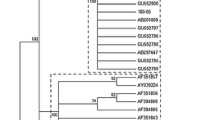Abstract
Rabies virus (RABV) isolates from two species of canids and three species of bats were analyzed by comparing the C-terminal region of the G gene and the G-L intergenic region of the virus genome. Intercluster identities for the genetic sequences of the isolates showed both regions to be poorly conserved. Phylogenetic trees were generated by the neighbor-joining and maximum parsimony methods, and the results were found to agree between the two methods for both regions. Putative amino acid sequences obtained from the G gene were also analyzed, and genetic markers were identified. Our results suggest that different genetic lineages of RABV are adapted to different animal species in Brazil.




Similar content being viewed by others
References
Fauquet CM, Mayo MA, Maniloff J, Desselberger U, Ball LA (2007) Virus taxonomy. In: Eighth Report of the International Committee on Taxonomy of Viruses. Academic Press, San Diego
Dietzschold B, Li J, Faber M, Schnell M (2008) Concepts in the pathogenesis of rabies. Future Virol 3(5):481–490
Childs JE, Real LA (2007) Epidemiology. In: Jackson AC, Wunner WH (eds) Rabies. Academic Press, San Diego, pp 123–199
OPS/OMS (2009) SIRVERA–Rabies. http://sirvera.panaftosa.org.br. Accessed 19 Dec 2009
World Health Organization–Expert Consultation on Rabies (2004) WHO Expert Consultation on Rabies First Report. WHO Technical Report Series 931, 1–12I, World Health Organization, Geneva, 121 p
Favoretto SR, Carrieri ML, Cunha EM, Aguiar EA, Silva LH, Sodre MM, Souza MC, Kotait I (2002) Antigenic typing of Brazilian rabies virus samples isolated from animals and humans, 1989–2000. Rev Inst Med Trop São Paulo 44(2):91–95
Páez A, Velasco-Villa A, Rey G, Rupprecht CE (2007) Molecular epidemiology of rabies in Colombia 1994–2005 based on partial nucleoprotein gene sequences. Virus Res 130(1–2):172–181
Favi CM, Rodríguez AL, Espinosa MC, Yung PV (2008) Rabies in Chile: 1989–2005. Rev Chilena Infectol 25(2):8–13
Nadin-Davis SA (2007) Molecular Epidemiology. In: Jackson AC, Wunner WH (eds) Rabies. Academic Press, San Diego, pp 69–122
David D, Hughes GJ, Yakobson BA, Davidson I, Un H, Aylan O, Kuzmin IV, Rupprecht CE (2007) Identification of novel canine rabies virus clades in the Middle East and North Africa. J Gen Virol 88(3):967–980
Ito M, Arai YT, Itou T, Sakai T, Ito FH, Takasaki T, Kurane I (2001) Genetic characterization and geographic distribution of rabies virus isolates in Brazil: identification of two reservoirs, dogs and vampire bats. Virology 284(2):214–222
Carnieli P Jr, Fahl WO, Castilho JG, Oliveira RN, Macedo CI, Durymanova E, Jorge RS, Morato RG, Spíndola RO, Machado LM, de Ungar Sá JE, Carrieri ML, Kotait I (2008) Characterization of Rabies virus isolated from canids and identification of the main wild canid host in Northeastern Brazil. Virus Res 131(1):33–46
Carnieli P Jr, Castilho JG, Fahl WO, Véras NM, Carrieri ML, Kotait I (2009) Molecular characterization of Rabies Virus isolates from dogs and crab-eating foxes in Northeastern Brazil. Virus Res 141(1):81–89
Kobayashi Y, Sato G, Kato M, Itou T, Cunha EM, Silva MV, Mota CS, Ito FH, Sakai T (2007) Genetic diversity of bat rabies viruses in Brazil. Arch Virol 152(11):1995–2004
Sato G, Itou T, Shoji Y, Miura Y, Mikami T, Ito M, Kurane I, Samara SI, Carvalho AA, Nociti DP, Ito FH, Sakai T (2004) Genetic and phylogenetic analysis of glycoprotein of rabies virus isolated from several species in Brazil. J Vet Med Sci 66(7):747–753
Thompson JD, Higgins DG, Gibson TJ (1994) CLUSTAL W: improving the sensitivity of progressive multiple sequence alignment through sequence weighting, position-specific gap penalties and weight matrix choice. Nucleic Acids Res 22(22):4673–4680
Hall TA (1999) BioEdit: a user-friendly biological sequence alignment editor and analysis program for Windows 95/98/NT. Nucl Acids Symp Ser 41:95–98
Tamura K, Dudley J, Nei M, Kumar S (2007) MEGA4: molecular evolutionary genetics analysis (MEGA) software version 4.0. Mol Biol Evol 24:1596–1599
Swofford D, Olsen G, Waddell P (1996) Phylogenetic inference. In: Hillis D (ed) Molecular systematics. Sunderland, Massachusetts, pp 407–514
Wunner WH (2007) Rabies. In: Jackson AC, Wunner WH (eds) Rabies virus. Academic Press, San Diego, pp 23–68
Carnieli P Jr, Castilho JG, de Oliveira Fahl W, Véras NM, do Carmo Sampaio Tavares Timenetsky M (2009) Genetic characterization of Rabies virus isolated from cattle between 1997 and 2002 in an epizootic area in the state of São Paulo, Brazil. Virus Res 144:215–224
Domingo E, Holland JJ (1997) RNA virus mutations and fitness for survival. Annu Rev Microbiol 51:151–178
Nadin-Davis SA, Muldoon F, Wandeler AI (2006) Persistence of genetic variants of the arctic fox strain of Rabies virus in southern Ontario. Can J Vet Res 70(1):11–19
Bourhy H, Kissi B, Tordo N (1993) Taxonomy and evolutionary studies on lyssaviruses with special reference to Africa. Onderstepoort J Vet Res 60:277–282
Sacramento D, Bourhy H, Tordo N (1991) PCR technique as an alternative method for diagnosis and molecular epidemiology of rabies virus. Mol Cell Probes 5:229–240
Zulu GC, Sabeta CT, Nel LH (2009) Molecular epidemiology of rabies: Focus on domestic dogs (Canis familiaris) and black-backed jackals (Canis mesomelas) from northern South Africa. Virus Res 140:71–78
Coetzee P, Nel LH (2007) Emerging epidemic dog rabies in coastal South Africa: a molecular epidemiological analysis. Virus Res 126:186–195
Velasco-Villa A, Orciari LA, Souza V, Juarez-Islas V, Gomez-Sierra M, Castillo A, Flisser A, Rupprecht CE (2005) Molecular epizootiology of rabies associated with terrestrial carnivores in Mexico. Virus Res 111(1):13–27
Kobayashi Y, Suzuki Y, Itou T, Carvalho AA, Cunha EM, Ito FH, Gojobori T, Sakai T (2010) Low genetic diversities of rabies virus populations within different hosts in Brazil. Infect Genet Evol 10(2):278–283
Author information
Authors and Affiliations
Corresponding author
Rights and permissions
About this article
Cite this article
Carnieli, P., de Oliveira Fahl, W., Brandão, P.E. et al. Comparative analysis of rabies virus isolates from Brazilian canids and bats based on the G gene and G-L intergenic region. Arch Virol 155, 941–948 (2010). https://doi.org/10.1007/s00705-010-0671-7
Received:
Accepted:
Published:
Issue Date:
DOI: https://doi.org/10.1007/s00705-010-0671-7




